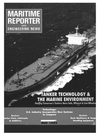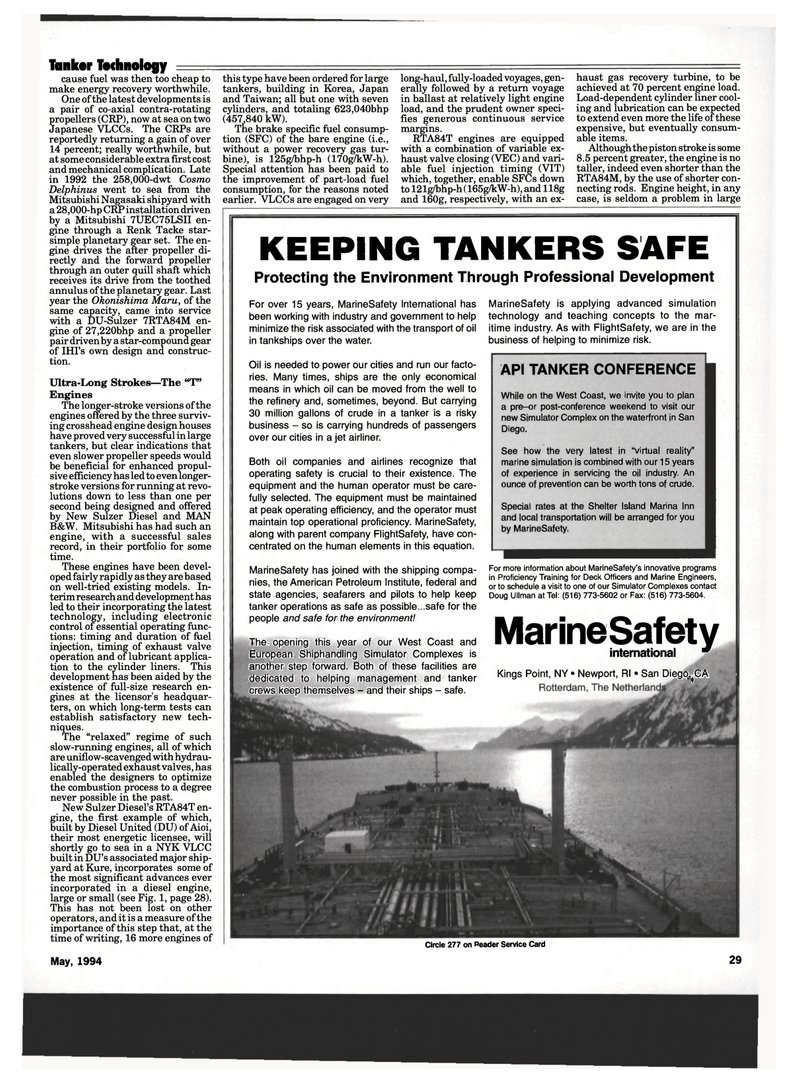
Page 27: of Maritime Reporter Magazine (May 1994)
Read this page in Pdf, Flash or Html5 edition of May 1994 Maritime Reporter Magazine
Tanker Technology = cause fuel was then too cheap to make energy recovery worthwhile.
One of the latest developments is a pair of co-axial contra-rotating propellers (CRP), now at sea on two
Japanese VLCCs. The CRPs are reportedly returning a gain of over 14 percent; really worthwhile, but at some considerable extra first cost and mechanical complication. Late in 1992 the 258,000-dwt Cosmo
Delphinus went to sea from the
Mitsubishi Nagasaki shipyard with a 28,000-hp CRP installation driven by a Mitsubishi 7UEC75LSII en- gine through a Renk Tacke star- simple planetary gear set. The en- gine drives the after propeller di- rectly and the forward propeller through an outer quill shaft which receives its drive from the toothed annulus of the planetary gear. Last year the Okonishima Maru, of the same capacity, came into service with a DU-Sulzer 7RTA84M en- gine of 27,220bhp and a propeller pair driven by a star-compound gear of IHI's own design and construc- tion.
Ultra-Long Strokes—The "T"
Engines
The longer-stroke versions of the engines offered by the three surviv- ing crosshead engine design houses have proved very successful in large tankers, but clear indications that even slower propeller speeds would be beneficial for enhanced propul- sive efficiency has led to even longer- stroke versions for running at revo- lutions down to less than one per second being designed and offered by New Sulzer Diesel and MAN
B&W. Mitsubishi has had such an engine, with a successful sales record, in their portfolio for some time.
These engines have been devel- oped fairly rapidly as they are based on well-tried existing models. In- terim research and development has led to their incorporating the latest technology, including electronic control of essential operating func- tions: timing and duration of fuel injection, timing of exhaust valve operation and of lubricant applica- tion to the cylinder liners. This development has been aided by the existence of full-size research en- gines at the licensor's headquar- ters, on which long-term tests can establish satisfactory new tech- niques.
The "relaxed" regime of such slow-running engines, all of which are uniflow-scavenged with hydrau- lically-operated exhaust valves, has enabled the designers to optimize the combustion process to a degree never possible in the past.
New Sulzer Diesel's RTA84T en- gine, the first example of which, built by Diesel United (DU) of Aioi, their most energetic licensee, will shortly go to sea in a NYK VLCC built in DU's associated major ship- yard at Kure, incorporates some of the most significant advances ever incorporated in a diesel engine, large or small (see Fig. 1, page 28).
This has not been lost on other operators, and it is a measure of the importance of this step that, at the time of writing, 16 more engines of
May, 1994 this type have been ordered for large tankers, building in Korea, Japan and Taiwan; all but one with seven cylinders, and totaling 623,040bhp (457,840 kW).
The brake specific fuel consump- tion (SFC) of the bare engine (i.e., without a power recovery gas tur- bine), is 125g/bhp-h (170g/kW-h).
Special attention has been paid to the improvement of part-load fuel consumption, for the reasons noted earlier. VLCCs are engaged on very long-haul, fully-loaded voyages, gen- erally followed by a return voyage in ballast at relatively light engine load, and the prudent owner speci- fies generous continuous service margins.
RTA84T engines are equipped with a combination of variable ex- haust valve closing (VEC) and vari- able fuel injection timing (VIT) which, together, enable SFCs down to 121g/bhp-h(165g/kW-h), and 118g and 160g, respectively, with an ex- haust gas recovery turbine, to be achieved at 70 percent engine load.
Load-dependent cylinder liner cool- ing and lubrication can be expected to extend even more the life of these expensive, but eventually consum- able items.
Although the piston stroke is some 8.5 percent greater, the engine is no taller, indeed even shorter than the
RTA84M, by the use of shorter con- necting rods. Engine height, in any case, is seldom a problem in large
KEEPING TANKERS SAFE
Protecting the Environment Through Professional Development
For over 15 years, MarineSafety International has been working with industry and government to help minimize the risk associated with the transport of oil in tankships over the water.
Oil is needed to power our cities and run our facto- ries. Many times, ships are the only economical means in which oil can be moved from the well to the refinery and, sometimes, beyond. But carrying 30 million gallons of crude in a tanker is a risky business - so is carrying hundreds of passengers over our cities in a jet airliner.
Both oil companies and airlines recognize that operating safety is crucial to their existence. The equipment and the human operator must be care- fully selected. The equipment must be maintained at peak operating efficiency, and the operator must maintain top operational proficiency. MarineSafety, along with parent company FlightSafety, have con- centrated on the human elements in this equation.
MarineSafety has joined with the shipping compa- nies, the American Petroleum Institute, federal and state agencies, seafarers and pilots to help keep tanker operations as safe as possible...safe for the people and safe for the environment!
The opening this year of our West Coast and
European Shiphandling Simulator Complexes is another step forward. Both of these facilities are dedicated to helping management and tanker crews keep themselves - and their ships - safe.
MarineSafety is applying advanced simulation technology and teaching concepts to the mar- itime industry. As with FlightSafety, we are in the business of helping to minimize risk.
API TANKER CONFERENCE
While on the West Coast, we invite you to plan a pre-or post-conference weekend to visit our new Simulator Complex on the waterfront in San
Diego.
See how the very latest in "virtual reality" marine simulation is combined with our 15 years of experience in servicing the oil industry. An ounce of prevention can be worth tons of crude.
Special rates at the Shelter Island Marina Inn and local transportation will be arranged for you by MarineSafety.
For more information about MarineSafety's innovative programs in Proficiency Training for Deck Officers and Marine Engineers, or to schedule a visit to one of our Simulator Complexes contact
Doug Ullman at Tel: (516) 773-5602 or Fax: (516) 773-5604.
MarineSafety international *
Kings Point, NY • Newport, Rl • San Diego^CA
Circle 277 on Reader Service Card 29

 26
26

 28
28
